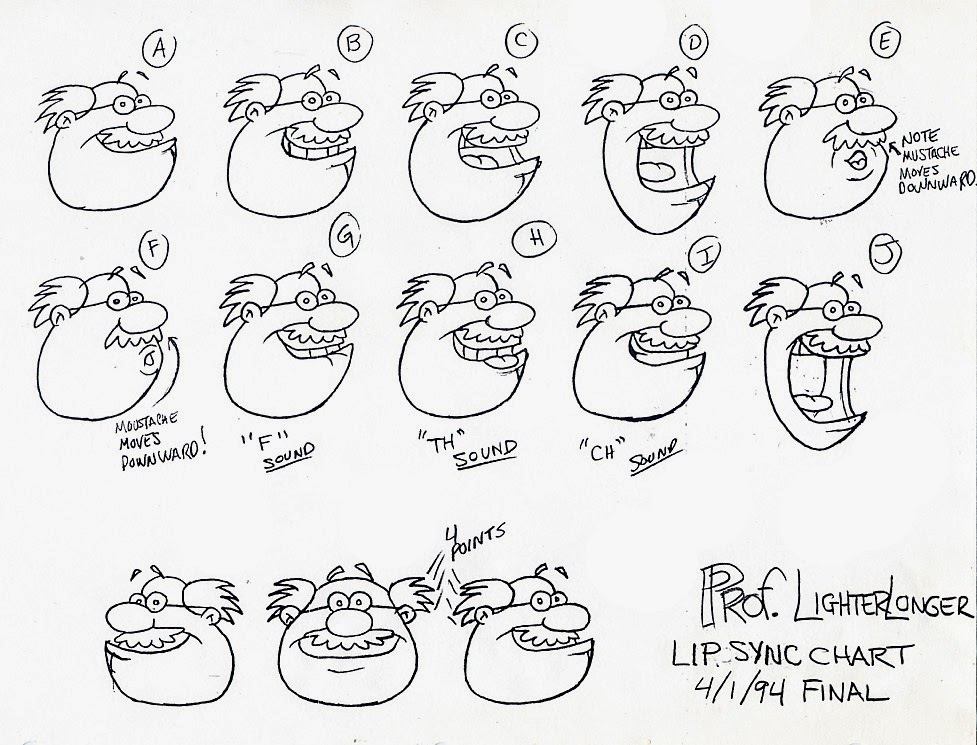Later, I got to read a sound track on an old school Steinbeck flat bed editor. This oven sized editing machine could play sound and picture together and was used to cut something called film, centuries ago. My task was to sit down on this beast, scroll thru the sound very slowly and breakdown the sounds unto the exposure sheet. Today, I do the same task using ToonBoom Animate Pro or Storyboard.
The more you do, the better you get and I discovered that you don't want your mouth position changing every frame. Its ok to have one position overlap a frame, because it will look more natural. It will not draw your attention to the speed of the mouth if its on two's, unless you have a character who is very fast and you want to show that in his speech pattern as well.
Breaking down the soundtrack is a process which is the same for both 2D and 3D animation and it will take sometime to do. Sometimes, I would have play as sound forward and backward to find where a the word started or ended. A weird thing I picked up while track reading was that the word "Yes", when played backwards will sound like "Say". And its better to read dialogue instead of having it with sound effects and music on the same track.
So, if I had a recorded line of a character's voice saying, "I will go..." I would listen to the take a few times and get an idea behind the performance. Then I would listen to the track very slowly, by scrubbing thru the sound file to see how long each word takes to say in frames.
The word "I" is made up of two sounds, "Ah" and "Ye". Said quickly or slowly, "I" could cover 2 to 6 frames of sound. An exposure sheet is incredibly useful in 2D animation and is necessary in writing down all the dialogue breakdown information. Here is an example of breakdown dialogue on an exposure sheet. Can you understand what is being said phonetically?
Here's a standard mouth chart used in Animaniacs. Notice how mouth H is similar to mouth C, except for the tongue placement. Also "Y" mouth is an inbetween of mouth B and mouth C, allowing a smoother transition from B to C.
Here are several Mouth charts for various characters from Animaniacs. These mouth positions were labelled on the X-sheets, so the animators knew what mouth to draw at which frame.
Below is a more snobby type character. Notice the differences in mouth design.
All of the above mouth charts are shown to be from a happy expression, but what if you have a character that goes from happy or sad or mad? I had a character who was a sarcastic bully and so my mouth chart shows happy mouths with angry mouths...
Below is a mouth chart of a friendlier character.
I was recently cleaning out my garage and can across some of my animation past. The above two mouth charts are from a video I designed and directed for the ThinkFirst Foundation. It was a short video teaching kids about spinal safety. The script was written by Jim Hardison and produced the video through his company called Image Dynamics in Chicago. I was hired to direct the animation. I found a production notebook full of modelsheets, color info, props and other things which brought back a lot of memories, good and bad.
If you learned something new, click on the ad to the right and the ad below this article, let us know you appreciate animation Thank You!









Hi Jim,
ReplyDeleteThanks for your great article! It's not easy to find quality information on lip-sync, much less with mouth charts!
I noticed that the first six mouth shapes (A-F) seem to have been identical at just about every animation studio. If a seventh mouth shape (G) is used, it's usally the 'F' sound. But after that, things stop being consistent:
* For most of the Animaniacs characters you showed, H-J are 'TH', 'CH', and a dropped jaw, respectively.
* For the Thomas character you showed, H is 'TH', but I is 'L'. No 'CH' or dropped jaw.
* The Frederator studios use 'L', 'TH', and 'Ooo' as additional shapes.
I'd love to hear your opinion about those additional mouth shapes! Does it pay off having more than seven shapes? Do you feel some mouth shapes add more value than others? And (this one keeps me puzzled): When would you actually use that 'dropped jaw' mouth shape?
Daniel
Great Questions! The first six mouth shapes are pretty much standard for animation any dialogue. For Animaniacs, they wanted to emphasized any "TH","CH" more on some characters than others. The first time I noticed a "TH" mouth, the teeth smile with a bit of tongue sticking out was when I first saw Ren and Stimpy.
DeleteHere's the mystery of the "Dropped Jaw"... 1) To show how far you can open the character's mouth and have it still be on model. and 2)Used for a Yell or a scream. where you could go from the "D" mouth to the "J" mouth with a few added inbetweens to smooth out the transition of the mouth increasing in size.
All in all, less is more. Too many mouth shapes gets confusing and all of these work well when used in this way. Hopefully this clears up a few things and thanks again for your comment!
Thanks for the explanation -- that certainly makes sense to me! I'll start with only the basic 6+1 shapes and see how things work out.
ReplyDeleteSend me a copy.
Delete